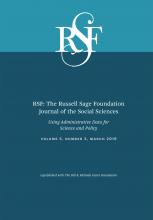Research Article
Open Access
Understanding Vulnerable Families in Multiple Service Systems Understanding Vulnerable Families
Robert M. Goerge, Emily R. Wiegand
RSF: The Russell Sage Foundation Journal of the Social Sciences March 2019, 5 (2) 86-104; DOI: https://doi.org/10.7758/RSF.2019.5.2.05
Robert M. Goerge
aSenior research fellow at Chapin Hall at the University of Chicago
Emily R. Wiegand
bResearcher at Chapin Hall at the University of Chicago

REFERENCES
- ↵
- Civic Caucus
- ↵
- Corbett, Thomas,
- James Dimas,
- James Fong, and
- Jennifer Noyes
- ↵
- ↵
- Fellegi, Ivan P., and
- Alan B. Sunter
- ↵
- Goerge, Robert M
- ↵
- Goerge, Robert M.,
- John van Voorhis, and
- Bong Joo Lee
- Grusky, David B.,
- Michael Hout,
- Timothy M. Smeeding, and
- C. Matthew Snipp
- ↵
- Hotz, V. Joseph,
- Robert M. Goerge,
- Julie Balzekas, and
- Francis Margolin
- ↵
- Jordan, B. Kathleen,
- Elizabeth B. Federman,
- Barbara J. Burns,
- William E. Schlenger,
- John A. Fairbank, and
- Juesta M. Caddell
- ↵
- Kitzmiller, Erika M
- ↵
- ↵
- Matos, Ana R., and
- Liliana M. Sousa
- ↵
- ↵
- ↵
- Meyer, Bruce D., and
- Robert Goerge
- ↵
- National Association of State Budget Officers
- ↵
- Newcombe, Howard B.,
- James M. Kennedy,
- S. J. Axford, and
- A. P. James
- ↵
- Pecora, Peter J.,
- Ronald C. Kessler,
- Kirk O’Brien,
- Catherine Roller White,
- Jason Williams,
- Eva Hiripi,
- Diana English,
- James White, and
- Mary Anne Herrick
- ↵
- Potter, Margaret A.,
- Patricia Sweeney,
- Clarke Thomas,
- Theresa M. Miller, and
- Tyler Less Gourley
- ↵
- ↵
- ↵
- ↵
- Sharlin, Shlomo A., and
- Michal Shamai
- ↵
- Shonkoff, Jack P.,
- Andrew S. Garner,
- Benjamin S. Siegel,
- Mary I. Dobbins,
- Marian F. Earls,
- Andrew S. Garner,
- Laura McGuinn,
- John Pascoe, and
- David L. Wood
- ↵
- ↵
- ↵
- Spratt, Trevor
- ↵
- ↵
- Substance Abuse and Mental Health Services Administration
- ↵
- ↵
- Teplin, Linda A.
- ↵
- ↵
- Wilkins, Carol
- ↵
In this issue
Understanding Vulnerable Families in Multiple Service Systems Understanding Vulnerable Families
Robert M. Goerge, Emily R. Wiegand
RSF: The Russell Sage Foundation Journal of the Social Sciences Mar 2019, 5 (2) 86-104; DOI: 10.7758/RSF.2019.5.2.05
Jump to section
Related Articles
- No related articles found.
Cited By...
- No citing articles found.





